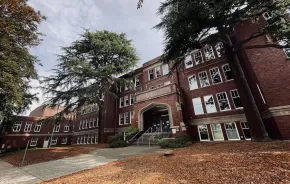
At 10:30 a.m. on a Monday, the first day of school, my kid saw a penis. Not a cartoon, a drawing or even a photo. A video feed of nudity and lewd gestures. My daughter is 12; she was in her seventh-grade science class, virtually, in our home in Florida.
This, of course, is according to her. The teacher was busy teaching the students in the real-life classroom. He shares his time between the two cohorts, trying to give each as much eye contact as possible. He didn’t see it. The video conference wasn’t recorded, so we can’t check the footage. The school did a cursory investigation, determined the teacher didn’t see it, and therefore that it didn’t happen.
My daughter saw male genitals for the first time, reported it to a trusted adult and was called a liar. Sounds about right for our society, but not right for our future.
“It’s misogyny. We’d rather believe a woman would lie than believe a man would attack,” says Lily Tsui, a sexual violence prevention consultant. “The world, and in this case, the school, wants to believe your girls are lying because that is literally more convenient for them.”
In my daughter’s case, I cannot prove the lewd visual display happened, but our school does acknowledge a Zoom bomb, many of which have happened in Florida K–12 schools, Washington state K–12 schools and schools throughout the country. A person had signed into the meeting under a fake username and yelled swear words and other adult content. The teacher scrambled to get back to his computer, took a minute to find the offending highlighted black box and kicked it out of the meeting. And not a thing was learned that day.
In Washington state, the school systems are a little more forthcoming about the problem, but it is disturbing nonetheless. Eckstein Middle School students were the victims of both racist language and pornographic imagery in their TEAMS meetings early on in the school year.
“As our school leader, I feel sorrow, anger and disgust around incidents that occurred in a couple of our TEAMS classroom meetings,” wrote Principal Kristin Rose in a district-wide email sent to parents. “The participant came in with a link that did not show as “guest” and instead impersonated a student’s name in the classroom. People with malicious intent are getting cleverer and we are working with District Technology on security for our classrooms district-wide.”
Meanwhile, in the Snoqualmie School District in Washington, school IT professionals had to scramble after five separate hacking attempts occurred, with one Zoom bomb showing bestiality. In King County, a family reported that someone assumed their child’s identity in a Zoom snafu.
“[He] was kicked out of his Zoom and an impersonator came in spreading racist and hateful comments,” said Stacey Ferro, a parent in the district.
Students and parents at North Thurston Public Schools received an email addressing “Zoombombings” and apologizing for disruptions. The communication outlined how the district was handling it and asked students not to give out their passwords and user IDs to anyone.
Sometimes it is the students themselves who make poor choices. “Our schools had to cancel mass orientations due to a high school group using the N-word, changing their profile avatars to inappropriate pictures. It was the students misbehaving,” says Sarah Paulson, a parent in the Clackamas County, Oregon, school district.
And here, too, my children saw avatars of vaginas, parading around while the mics on their computers blared out “F*** you, you ain’t s***!” and “I’m leaving to jerk off now,” while the teacher frantically tried to remove the offensive content.
All of this is awful, but I don’t blame the schools. They, like all public schools across the nation, are white-knuckling this remarkably difficult school year. They are trying to make the impossible happen. They are working triple-time to give every student the best education they can. No matter how hard they work, they are being hamstrung by the government.
While Zoom bombs might be our raciest problem, they are far from the only problem. On Miami’s first day of school, the entire system went down and no one knew why. Miami-Dade County is the fourth-largest district in the nation, and hundreds of thousands of students were disenfranchised. As accessibility is a huge problem, Miami opted for a staggered reopening of all schools in October because they can’t get their students to show up online.
Across the United States, we’re experiencing not only connectivity issues, but also capacity, access and supply issues.
“Needs from the district have been a nightmare,” notes a teacher in Brevard County, Florida, who asked for anonymity for fear of blowback. “We have extra paperwork doubling up on other papers that cover the exact same thing. We had to amend every single IEP with three days’ notice. I have no idea how to properly support e-learners.”
That’s in addition to our race against the clock on teacher exhaustion. In states where schools have opened and districts support hybrid learning options, teachers accustomed to normal class sizes of 20–25 students now find themselves with that many kids to instruct in real-life classrooms and perhaps a dozen or more joining via Zoom.
In Summit County, Ohio, schools are putting two virtual teachers in one classroom in the school building. This way, the teachers can oversee brick-and-mortar tasks for the classroom, such as taking temperatures. But it also means that students online must listen to two classes going on at once, which can be distracting and confusing, says Maya Brown-Zimmerman, who teaches both elementary and middle school students.
“I know other parents have complained and gotten pushback,” says Brown-Zimmerman. “It’s bad enough that my husband is going to compose an email to send to the school this weekend, with a video that I took to show the sound issues.”
“The Hyflex [hybrid] classes are terrible,” notes Melissa Borkowski, parent to an Alachua County, Florida, seventh-grader. “The teacher walks away, and we have no idea what is going on. We can’t hear them half the time and four out of the six classes were on for 5 minutes, then they say the Zoom kids can sign off.”
My child, too, has been asked to be present for attendance, then asked to sign out with no instruction given or work assigned. When links don’t work, or none are provided, my kids are counted as absent. Assignments are coming and going, and we’re at risk of falling behind.
“Our online and hybrid classes can have up to 35 kiddos. My first period currently has 20 online and 13 in person,” says Rachel Miller, a high school social studies teacher in Pasco County, Florida. “I feel like I am ignoring one group over the other all the time. I have zero connections being made with my online kiddos. I go back and forth between both groups and check to see if the online kids are engaged.”
But let’s look at what this really is. It is yet another hit to the public-school system. It’s nationwide, not just state by state. When President Trump first appointed Betsy DeVos, he did so with the intent that she dismantle the institution she was heading. We’ve seen the attacks on our postal service, environmental protection agency and now our schools, all exacerbated by COVID-19. People need relief.
If teachers quit because the stress is too high and the demands too much for too long, the school system will buckle. If support staff — bus drivers, custodians, administrators — feel unappreciated, or worse, are put in danger in the course of doing their jobs, the system shakes. If even 5 or 10 percent of parents grow frustrated with the public schools and pull their kids into homeschooling, private or parochial options, it crumbles.
I don’t want my daughters’ schooling to go to the highest bidder. Education is no longer simply the cornerstone of our children’s futures, it’s now a politically fraught fight. Don’t let our young students be collateral damage in a political war.











